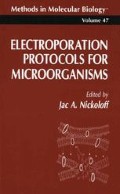Abstract
Borrelia burgdorferi is an etiologic agent of Lyme disease, the most common arthropod-borne disease in the United States (1,2). The bacterium, a member of the spirochete phylum, has a genome predominantly composed of linear DNA molecules (3,4). Formulating a medium in which B. burgdorferi grows in vitro was the first step toward a genetic understanding of the physiology and pathogenesis of the organism (5,6). The growth of B. burgdorferi as single colonies in solid medium (7–9) has facilitated mutant isolation by selection (10,11), although a defined medium for selection of auxotrophs is not currently available. The transformation system described in this chapter will be useful for manipulating the spirochete on a molecular genetic level.
Access this chapter
Tax calculation will be finalised at checkout
Purchases are for personal use only
References
Steere, A. C. (1989) Medical progress. Lyme disease. N. Engl. J. Med. 321, 586–596.
Barbour, A. G. and Fish, D. (1993) The biological and social phenomenon of Lyme disease. Science 260, 1610–1616.
Hinnebusch, J. and Tilly, K. (1993) Linear plasmids and chromosomes in bacteria. Mol. Microbiol. 10, 917–922.
Saint Girons, I., Old, I. G., and Davidson, B. E (1994) Molecular biology of the Borrelia, bacteria with linear replicons. Microbiology 140, 1803–1816.
Burgdorfer, W., Barbour, A. G., Hayes, S. F., Benach, J. L., Grunwaldt, E., and Davis, J. P. (1982) Lyme disease—a tick-borne spirochetosis? Science 216, 1317–1319.
Barbour, A. G. (1984) Isolation and cultivation of Lyme disease spirochetes. Yale J. Biol. Med. 57, 521–525
Kurtti, T. J., Munderloh, U. G., Johnson, R. C., and Ahlstrand, G. G. (1987) Colony formation and morphology in Borrelia burgdorferi. J. Clin. Microbiol. 25, 2054–2058.
Bundoc, V. G. and Barbour, A. G. (1989) Clonal polymorphisms of outer membrane protein OspB of Borrelia burgdorferi Infect. Immun. 57, 2733–2741.
Rosa, P. A. and Hogan, D. M. (1992) Colony formation by Borrelia burgdorferi in solid medium: clonal analysis of osp locus variants, in First International Conference on Tick-Borne Pathogens at the Host-Vector Interface: An Agenda for Research (Munderloh, U. G. and Kurtti, T. J., eds.), University of Minnesota, St. Paul, pp. 95–103.
Šadžiene, A., Rosa, P. A., Thompson, P. A., Hogan, D. M., and Barbour, A. G. (1992) Antibody-resistant mutants of Borrelia burgdorferi: in vitro selection and characterization. J. Exp. Med. 176, 799–809.
Samuels, D. S., Marconi, R. T., Huang, W. M., and Garon, C. F. (1994) gyrB mutations in coumermycin A1-resistant Borrelia burgdorferi. J. Bacteriol. 176, 3072–3075.
Shigekawa, K. and Dower, W. J. (1988) Electroporation of eukaryotes and prokaryotes: a general approach to the introduction of macromolecules into cells. BioTechniques 6, 742–751.
Trevors, J. T., Chassy, B. M., Dower, W. J., and Blaschek, H. P. (1992) Electrotransformation of bacteria by plasmid DNA, in Guide to Electroporation and Electrofusion (Chang, D. C., Chassy, B. M., Saunders, J. A., and Sowers, A. E., eds.), Academic, San Diego, pp. 265–290.
ter Huurne, A. A. H. M., van Houten, M., Muir, S., Kusters, J. G., van der Zeijst, B. A. M., and Gaastra, W. (1992) Inactivation of a Serpula (Treponema) hyodysenteriae hemolysin gene by homologous recombination: importance of this hemolysin in pathogenesis of S. hyodysenteriae in mice. FEMS Microbiol. Lett. 92, 109–114.
Sambri, V. and Lovett, M. A. (1990) Survival of Borrelia burgdorferi in different electroporation buffers. Microbiologica 13, 79–83.
Samuels, D. S., Mach, K. E., and Garon, C. F. (1994) Genetic transformation of the Lyme disease agent Borrelia burgdorferi with coumarin-resistant gyrB. J. Bacteriol. 176, 6045–6049.
Samuels, D. S. and Garon, C. F. (1993) Coumermycin A1 inhibits growth and induces relaxation of supercoiled plasmids in Borrelia burgdorferi, the Lyme disease agent. Antimicrob. Agents Chemother. 37, 46–50.
Cinco, M. (1992) Selection of a Borrelia burgdorferi antigenic variant by cultivation in the presence of increasing amounts of homologous immune serum. FEMS Microbiol. Lett. 92, 15–18.
Coleman, J. L., Rogers, R. C., and Benach, J. L. (1992) Selection of an escape variant of Borrelia burgdorferi by use of bactericidal monoclonal antibodies to OspB. Infect. Immun. 60, 3098–3104.
Dower, W. J., Chassy, B. M., Trevors, J. T., and Blaschek, H. P. (1992) Protocols for the transformation of bacteria by electroporation, in Guide to Electroporation and Electrofusion (Chang, D. C., Chassy, B. M., Saunders, J. A., and Sowers, A. E., eds.), Academic, San Diego, pp. 485–499.
Author information
Authors and Affiliations
Editor information
Editors and Affiliations
Rights and permissions
Copyright information
© 1995 Humana Press Inc.
About this protocol
Cite this protocol
Samuels, D.S. (1995). Electrotransformation of the Spirochete Borrelia burgdorferi . In: Nickoloff, J.A. (eds) Electroporation Protocols for Microorganisms. Methods in Molecular Biology™, vol 47. Humana Press. https://doi.org/10.1385/0-89603-310-4:253
Download citation
DOI: https://doi.org/10.1385/0-89603-310-4:253
Publisher Name: Humana Press
Print ISBN: 978-0-89603-310-8
Online ISBN: 978-1-59259-534-1
eBook Packages: Springer Protocols

